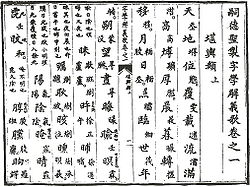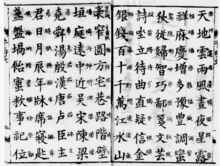| Tự Đức thánh chế tự học giải nghĩa ca | |
|---|---|
| 嗣德聖製字學解義歌 | |
 The first page of 嗣德聖製字學解義歌 - Tự Đức thánh chế tự học giải nghĩa ca. The first page of 嗣德聖製字學解義歌 - Tự Đức thánh chế tự học giải nghĩa ca. | |
| Compiled by | Tự Đức 嗣德 |
| Language | Vietnamese (Written in chữ Nôm) and Literary Chinese |
| First printed edition | 19th century |
| Verse form | Lục bát 六八 |
Tự Đức thánh chế tự học giải nghĩa ca (chữ Hán: 嗣德聖製字學解義歌; 'Emperor Tự Đức's sagely study of character creation and interpretation song') is a Vietnamese book that teaches Chinese characters (chữ Hán) through chữ Nôm. It was complied by the emperor of the Nguyễn dynasty, Tự Đức (1848–1883), around the 19th century. The book itself contains 13 volumes which are organized into 7 major categories. It is written in the Vietnamese lục bát 六八 verse form. It is considered to be an important dictionary for chữ Nôm researchers as it is a fairly complete Hán-Nôm dictionary with no ambiguous characters.
Background
The book and its 13 volumes contains 4,572 verses written in lục bát 六八 verse form. Within all of these verses, contains 32,004 characters with 9,028 of them being Chinese characters. It can be considered as a bilingual Literary Chinese - Vietnamese character dictionary. The book shows Chinese characters being glossed with chữ Nôm in smaller print. The annotations can range from one character to multiple characters, for example on the fifth line, 月 and 日 are annotated with 𩈘𦝄 and 𩈘𡗶 respectively.
- Kham dư loại 堪輿類: (Volumes 1–2; 上-下) contains characters about both astronomy and geography.
- Nhân sự loại 人事類: (Volumes 3–5; 上-中-下) contains characters about human relationships and society.
- Chính hóa loại 政化類: (Volumes 6–7; 上-下) contains characters about education.
- Khí dụng loại 器用類: (Volumes 8–9; 上-下) contains characters about object of everyday use.
- Thảo mộc loại 草木類: (Volumes 10–11; 上-下) contains characters about plants and trees.
- Cầm thú loại 禽獸類: (Volume 12) contains characters about wild animals.
- Trùng ngư loại 虫魚類: (Volume 13) contains characters about insects, shrimp, and fishes.

According to statistics by Nguyễn Thị Lan, Tự Đức thánh chế tự học giải nghĩa ca holds the largest collection of Chinese characters that are annotated with chữ Nôm. Hà Đăng Việt states that the Nôm in the book mainly uses three methods of creating characters, giả tá 假借 (phonetic loan), hình thanh 形聲 (phonosemantic compounding), and hội ý 會意 (compound ideographs). But most characters fall into the method of hình thanh 形聲 (phonosemantic compounding) as it was seen as the correct way of writing chữ Nôm.

| Book | Number of Chinese characters |
|---|---|
| 嗣德聖製字學解義歌 Tự Đức thánh chế tự học giải nghĩa ca | 9,028 |
| 大南國語 Đại Nam quốc ngữ | 4779 |
| 南方名物備考 Nam phương danh vật bị khảo | 4461 |
| 指南玉音解義 Chỉ nam ngọc âm giải nghĩa | 3394 |
| 三千字解音 Tam thiên tự giải âm | 2988 |
| 日用常談 Nhật dụng thường đàm | 2560 |
| 難字解音 Nan tự giải âm | 1066 |
| 千字文解音 Thiên tự văn giải âm | 1000 |
The book itself has been transliterated into the Vietnamese alphabet by Trần Kinh Hòa and was republished by Chinese University of Hong Kong (香港中文大學) in 1971.
Text
| Chinese characters and chữ Nôm | Vietnamese alphabet | English translation |
|---|---|---|
| 天𡗶地𡐙位𡾵 | Thiên trời địa đất vị ngôi | "Thiên" heaven, "Địa" earth, "Vị" seat |
| 覆𩂏載𬩅流㵢滿𣹓 | Phú che tái chở lưu trôi mãn đầy | "Phú" to cover, "tái" to deliver, "lưu" to flow, "mãn" to overflow |
| 高高博𢌌厚𠫆 | Cao cao bác rộng hậu dầy | "Cao" tall, "bác" wide, "hậu" thick |
| 晨𣈕暮𣋁轉搓移移 | Thần mai mộ tối chuyển xây di dời | "Thần" dawn, "mộ" dusk, "chuyển" to revolve, "di" to move |
| 月𩈘𦝄日𩈘𡗶 | Nguyệt mặt trăng nhật măt trời | "Nguyệt" the moon, "nhật" the sun |
| 照𥋸臨細世𠁀年𢆥 | Chiếu soi lâm tới thế đời niên năm | "Chiếu" to shine, "lâm" to arrive, "thế" generation, "niên" year |

- Words in bold are words that rhyme. The book is written in lục bát 六八 verse form as can be seen with these lines (six and eight syllable alternating verses). Words are rhymed every sixth and eighth syllable.
See also
Notes
- An example would be the character annotating 地, instead of 坦 (a commonly used character, but is also found in Literary Chinese texts; thản), the character 𡐙 is used instead.
- The characters 上-下 refers to the first and second parts of the volume. 中 refers to the middle part of the volume. Such as in the title of first volume, 卷之一 堪輿類 上 (in smaller print).
- Both of the characters (移) are marked with the nháy diacritic 𖿱. This means that dời is a Non-Sino-Vietnamese reading of 移 di.
- The character is ⿱召灬 for 照, but is not currently encoded into Unicode. It is used instead of 照 because of a naming taboo since a lot of characters are missing their 日 radical such as in 照 and 𣈜.
Further reading
- 嗣德聖製字學解義歌 - Tự Đức thánh chế tự học giải nghĩa ca (q.01-03)
- 嗣德聖製字學解義歌 - Tự Đức thánh chế tự học giải nghĩa ca (q.04-06)
- Tự-Đức Thánh-chế tự-học giải-nghĩa-ca
- 陳荆和 - 嗣德聖製字學解義歌譯註-香港中文大學 (1971)
References
- "Tự Đức thánh chế tự học giải nghĩa ca". Báo Tuổi Trẻ. 8 June 2005.
- ^ Hà, Đăng Việt (2006). "Tự Đức thánh chế tự học giải nghĩa ca và vấn đề chuẩn hóa chữ Nôm thời Nguyễn" (PDF). Đại học Khoa học Huế: 1.
- Nguyễn, Hữu Quỳ (1971). Tự-Đức Thánh-ché̂ tự-học giải-nghĩa-ca. Vol. 1. Phủ quó̂c vụ khanh đặc trách văn hóa. p. 4.
- Nguyễn, Đình Hòa. "Vietnamese phonology and Graphemic Borrowings from Chinese: The book of 3,000 characters Revisited" (PDF). Mon-Khmer Studies.
- ^ Hoàng, Thị Thu Thủy. Đặc trưng thông tục hóa trong nội dung vấ biên soạn từ thư Hán Nôm Việt Nam. Từ điển Bách khoa. p. 62.
- ^ Nguyễn, Quốc Khánh (2007). "Thử tìm hiểu chữ Nôm trong Tự Đức thánh chế tự học giải nghĩa ca". Institute of Hán-Nôm Studies.
- Hà, Đăng Việt (2006). "Tự Đức thánh chế tự học giải nghĩa ca và vấn đề chuẩn hóa chữ Nôm thời Nguyễn" (PDF). Đại học Khoa học Huế: 2.
- ^ Hà, Đăng Việt (2006). "Chữ Nôm trong Tự Đức Thánh chế tự học giải nghĩa ca". Thư viện số tài liệu nội sinh: 12.
- Hà, Đăng Việt (2006). "Chữ Nôm trong Tự Đức Thánh chế tự học giải nghĩa ca". Thư viện số tài liệu nội sinh: 15.
- Hà, Đăng Việt (2006). "Chữ Nôm trong Tự Đức Thánh chế tự học giải nghĩa ca". Thư viện số tài liệu nội sinh: 48.
- "Tự Đức Thánh chế tự học giải nghĩa ca". Hoằng Hóa Xã. 24 November 2020. Archived from the original on September 30, 2023.
| This article needs additional or more specific categories. Please help out by adding categories to it so that it can be listed with similar articles. (June 2023) |